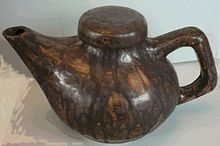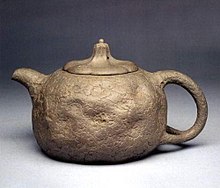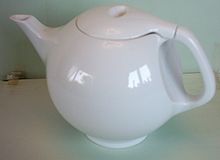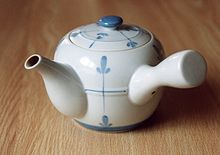Teapot
![]()
This article is about the teapot as a vessel; for the teapot company, see Teapot (company).
The teapot is a bulbous, rarely cylindrical vessel made of silver, brass, copper, iron, stoneware, porcelain or glass, in which tea can be prepared, kept warm, transported and served. The teapot differs from a coffee pot in three special characteristics:
- It is about as wide as it is tall, or even wider than it is tall. This allows the colorants and aromas that escape from the infused tea leaves and have a tendency to remain at the bottom to spread more evenly throughout the water than with a slender pot.
- The spout of the teapot is attached much lower, often even at the very bottom of the pot body, in order to be able to pour the colourings and aromas concentrated in the lower part of the pot into the drinking vessel first. (In the case of the coffee pot, the spout is attached to the top so that possible coffee grounds do not get into the cup).
- There is usually a built-in device that retains the brewed tea leaves during pouring. This can be sieve holes in the transition from the pot body to the spout or a conical filter insert that is hung from the top of the pot and extends to the bottom of the pot.
While the first documented mention of tea in China dates back to 221 BC (tea tax notice), teapots made specifically for tea preparation from the red Zǐshā clay of the southern Chinese region around Yixing do not appear until the Ming dynasty (1368-1644). Tea preparation by frothing green powder tea directly in the drinking bowl, which had been common until then, gave way to preparation by brewing the leaves in a teapot. In the culture of the late Ming and subsequent Qing dynasties, the shared consumption of exquisite teas prepared in high-quality pots played a central role as a symbol of social status and elevated culture. Scholars and nobles worked closely with potters, calligraphers and visual artists to create vessels that were as unique as possible.
Chinese tea was first imported into Europe at the beginning of the 17th century by the Dutch East India Company. A teapot is first documented in the inventory of a Portuguese trader from Macao in 1620. In the cargo of a ship that sank in the South China Sea in 1643, some 23,000 objects made of porcelain were found, including 255 teapots. The shape and colouring of the ceramic objects identify them as Chinese export porcelain for Europe. The first teapots preserved in Europe itself date from the late 17th century. One of the earliest known illustrations of a pot made of red Yixing clay, whose material and design clearly indicate its use as a teapot, is found in several paintings by Pieter Gerritsz. van Roestraeten (1627-1698). Towards the end of the 1670s, European ceramists such as Arij de Milde in Delft, John and David Elers in Staffordshire, England, and at the beginning of the 18th century Johann Friedrich Böttger in Meissen began to produce teapots based on Chinese models.
In the 17th and 18th centuries, England developed a pear-shaped teapot with an s-shaped bent spout, which was introduced to Morocco by the English along with green tea, and whose shape is still the model for most teapots in the tea culture of northwest Africa today.
As a serving vessel, teapots are naturally the focal point of a table and are thus often the figurehead of the respective design in tableware series. They come in a wide variety of colours, shapes and sizes, purely functional or figuratively kitschy with all variations in between. Teapots are also collector's items and exhibited in relevant museums.

Ceramic teapot, around 1980

The "Gong Chun teapot" (Chinese 供春壶), one of the oldest known teapots in the world, replica of Gu Jingzhou. The original is in the Beijing Palace Museum.

Teapot from the Fürstenberg manufactory, 1999

Japanese yokode-kyūsu type teapot
See also
- Can
- Gaiwan
- Kyūsu
- Russell's teapot
- Samovar
- Teapot Effect
- Tea bags
- Utah Teapot
- Yixing Teapot
Search within the encyclopedia